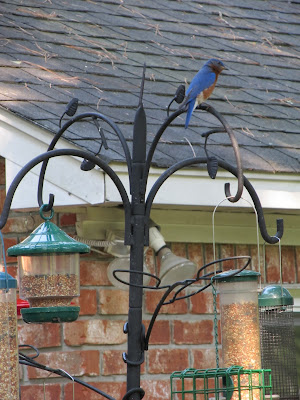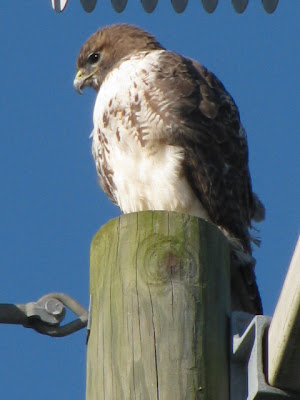I'll be adding to this posting through the summer....
At the suggestion of a bird artist I met at Spoleto this year I've started putting out Parakeet food in hopes of attracting Painted Buntings. I may have seen a female at my feeder a couple times. But it's also attracted what my birding friends Tammy and Tom say is a juvenile Brown-Headed Cowbird (above left with a Carolina Chickadee at the suet).
My backyard buffet has been doing brisk business among our avian friends. The warmer weather has birds such as this Carolina Chickadee hitting the birdbaths more and more.
A Tufted Titmouse (below) is feeling the heat. I saw this bird and a Chickadee also with its mouth open. The
temperatures here have been in the mid-90s.
A Northern Cardinal with a billfull of seed. I never tire of this bird's brilliant red.
The black around its face and black eyes do give the Cardinal a pretty fierce look.
In recent weeks, Eastern Bluebirds have been visiting our feeders. This bird's blue is as brilliant as the Cardinal's red!
Yesterday two Bluebirds came to my birdbath, just feet from where I was sitting. Unfortunately I didn't have my camera. But I'll try to be ready should it happen again!
A Carolina Wren (top) and Downy Woodpecker share some suet.
A Carolina Chickadee has its turn with the suet.
A Canada Goose couple had five babies this spring. They hang around the pond behind our house.
Aren't they cute?
There were five little ones, but sadly one of them must have died because there are only four now.
The family stops by several times a day to feed on seeds that have fallen from our bird feeders. After just a few weeks, look how big the "babies" are already!
In just a matter of weeks, the young ones are almost as large as their parents.
This is a photo I really like with a Northern Cardinal and an Eastern Bluebird on my hammock at the same time. Only thing missing is me on the hammock!
A backyard visitor we would like to see less of is...guess who???























































